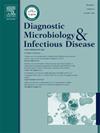Targeting Pseudomonas aeruginosa PAO1 pathogenicity: The role of Glycyrrhiza glabra in inhibiting virulence factors and biofilms
IF 2.1
4区 医学
Q3 INFECTIOUS DISEASES
Diagnostic microbiology and infectious disease
Pub Date : 2024-12-28
DOI:10.1016/j.diagmicrobio.2024.116674
引用次数: 0
Abstract
Pseudomonas aeruginosa (P. aeruginosa) is a Gram-negative opportunistic pathogen posing serious risks to immunocompromised individuals due to its virulence factors and biofilm formation. This study evaluated the efficacy of methanol extract of Glycyrrhiza glabra (G. glabra) in mitigating P. aeruginosa PAO1 pathogenesis through in-vitro assays, including Minimum Inhibitory Concentration (MIC), biofilm assay, growth curve analysis, pyocyanin quantification, and molecular docking. The extract inhibited PAO1 growth at 5 mg/mL and demonstrated significant antibiofilm activity at sub-MIC levels, reducing biofilm formation by 50.22 %, 22.13 %, and 11.53 % at concentrations of 1.25 mg/mL, 0.625 mg/mL, and 0.312 mg/mL, respectively. Pyocyanin production was also significantly suppressed. Molecular docking revealed that 4-(4-Trifluoromethyl-benzoylamino)-benzoic acid and betulinic acid, identified in the extract, exhibited strong binding affinities (−6.4 kcal/mol and −6.9 kcal/mol) to the QS regulator 7XNJ. These findings underscore the potential of G. glabra as an antipathogenic agent against P. aeruginosa, warranting further investigation into its clinical applications.
针对铜绿假单胞菌PAO1致病性的研究:甘草在抑制毒力因子和生物膜中的作用。
铜绿假单胞菌(P. aeruginosa)是一种革兰氏阴性条件致病菌,由于其毒力因子和生物膜的形成,对免疫功能低下的个体构成严重风险。本研究通过最低抑菌浓度(MIC)、生物膜测定、生长曲线分析、pyocyanin定量、分子对接等体外实验,评价Glycyrrhiza glabra (G. glabra)甲醇提取物对铜绿假单胞菌PAO1致病机制的抑制作用。该提取物在浓度为5 mg/mL时抑制PAO1的生长,在亚mic水平下表现出显著的抗生物膜活性,在浓度为1.25 mg/mL、0.625 mg/mL和0.312 mg/mL时,生物膜的形成分别减少50.22%、22.13%和11.53%。Pyocyanin的产生也被显著抑制。分子对接发现,提取液中鉴定的4-(4-三氟甲基苯甲酰胺)-苯甲酸和白桦酸对QS调节因子7XNJ具有较强的结合亲和力(-6.4 kcal/mol和-6.9 kcal/mol)。这些发现强调了光斑草作为铜绿假单胞菌抗致病性药物的潜力,值得进一步研究其临床应用。
本文章由计算机程序翻译,如有差异,请以英文原文为准。
求助全文
约1分钟内获得全文
求助全文
来源期刊
CiteScore
5.30
自引率
3.40%
发文量
149
审稿时长
56 days
期刊介绍:
Diagnostic Microbiology and Infectious Disease keeps you informed of the latest developments in clinical microbiology and the diagnosis and treatment of infectious diseases. Packed with rigorously peer-reviewed articles and studies in bacteriology, immunology, immunoserology, infectious diseases, mycology, parasitology, and virology, the journal examines new procedures, unusual cases, controversial issues, and important new literature. Diagnostic Microbiology and Infectious Disease distinguished independent editorial board, consisting of experts from many medical specialties, ensures you extensive and authoritative coverage.

 求助内容:
求助内容: 应助结果提醒方式:
应助结果提醒方式:


